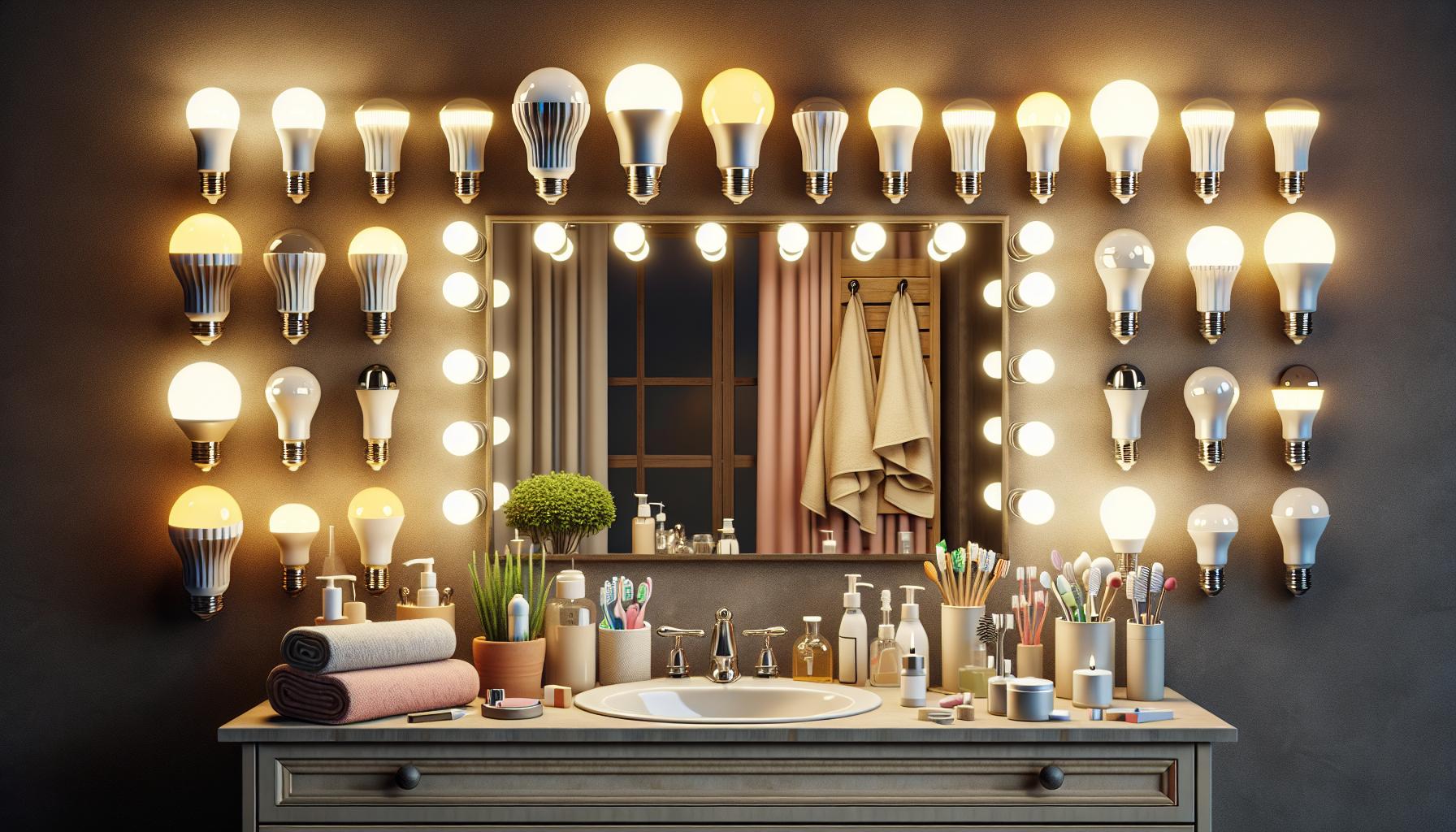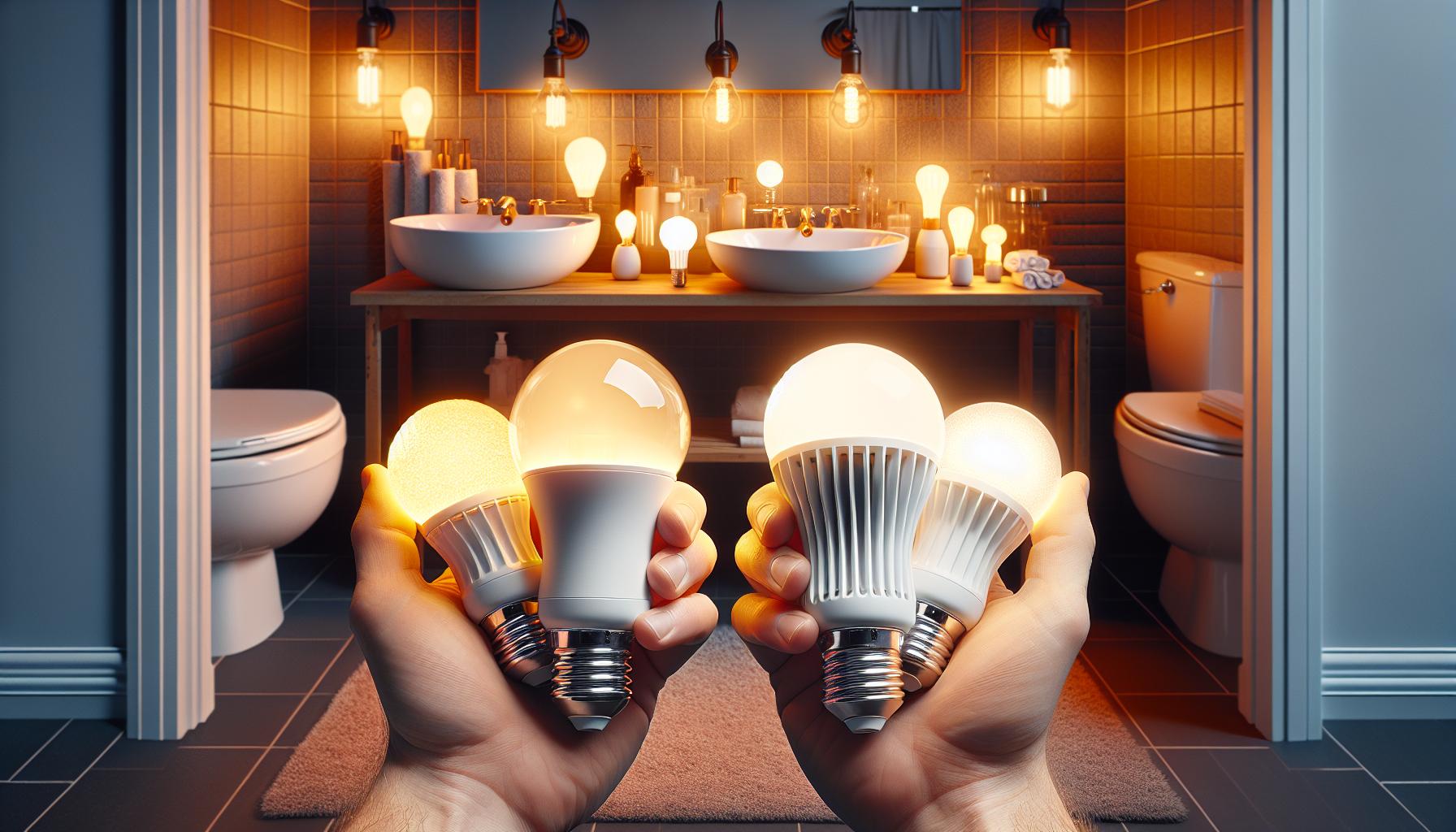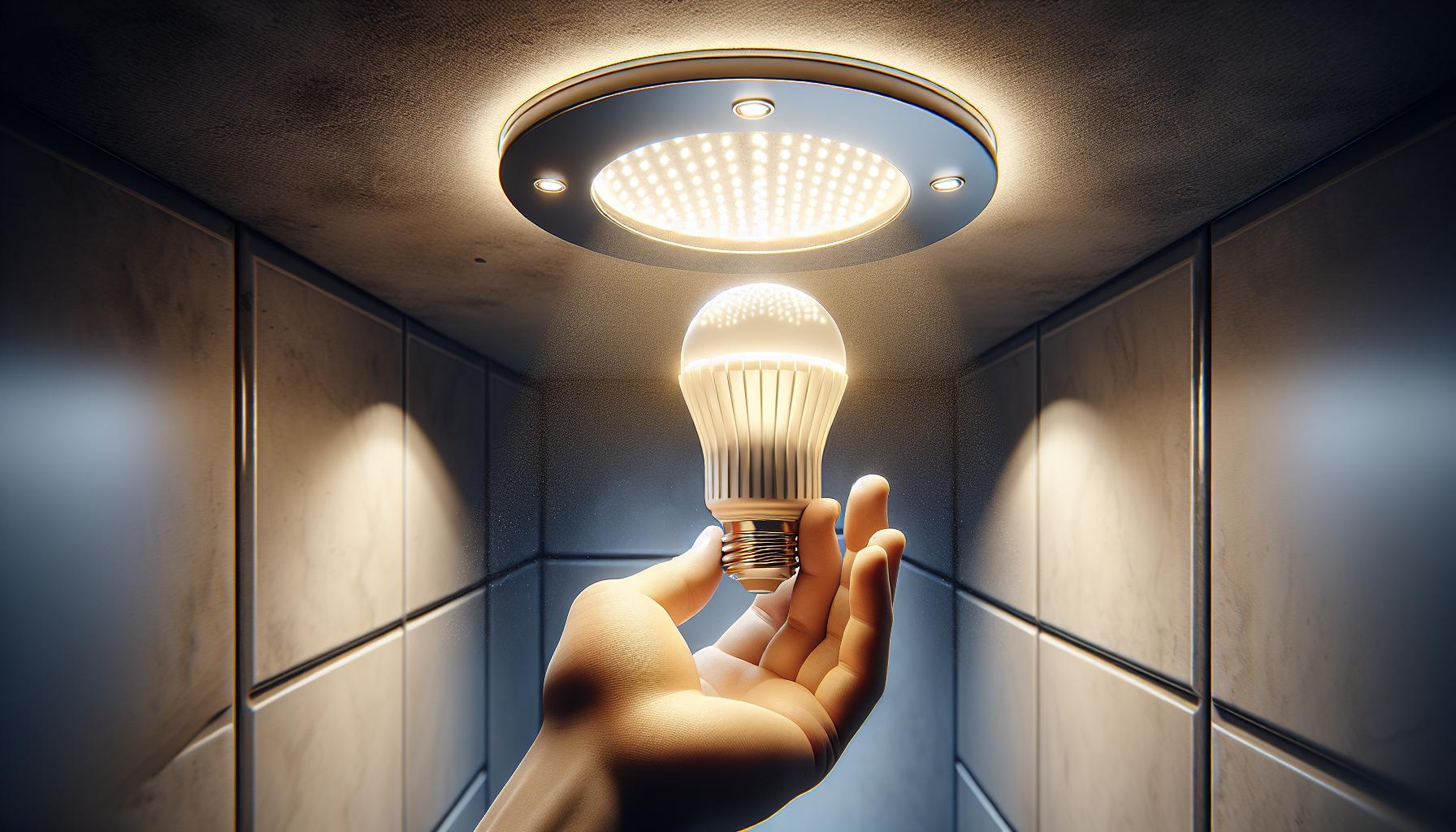Choosing the right light bulbs for your bathroom isn’t just about brightness; it’s about setting the mood and ensuring safety. You want to start your day off right with lighting that’s both flattering and functional.
But with so many options out there, how do you know which bulbs are the best fit for your bathroom vanity, shower, or overhead lights? Don’t worry, you’re about to get illuminated on everything from lumens to color temperature.
Importance of choosing the right light bulbs for the bathroom
When it comes to bathroom lighting, you’re not just choosing bulbs—you’re setting the stage for your daily rituals. The right lighting can transform an ordinary bathroom into a sanctuary of comfort and style.
First off, safety is a key consideration. Bathrooms are prone to moisture and the occasional water splash, making it crucial to select light bulbs that are suitable for wet or damp environments. Look for bulbs specifically designed for these conditions to ensure longevity and reduce the risk of electrical hazards.
Brightness is another factor you can’t ignore. Lumens measure the amount of light a bulb emits; the higher the lumens, the brighter the light. For most bathrooms, bulbs ranging from 500 to 1,000 lumens typically strike the right balance. Here’s a quick chart for reference:
| Bathroom Area | Lumens Range |
|---|---|
| Vanity | 1,000-1,800 Lumens |
| Shower | 500-700 Lumens |
| General | 700-1,000 Lumens |
Next, consider the color temperature of your bulbs, measured in Kelvin (K). Color temperature affects the mood and functionality of your bathroom:
- Cool White (3500K – 4100K): Offers a more energizing environment, perfect for applying makeup or grooming.
- Warm White (2000K – 3000K): Creates a cozy and relaxing atmosphere, ideal for unwinding in the tub.
Don’t overlook the bulb types. LED bulbs are the go-to choice these days, thanks to their energy efficiency and long lifespan. Moreover, they come in a variety of shapes and styles, which means you can customize your bathroom’s look without sacrificing functionality.
Whether you’re starting the day with a shave or ending it with a soak, the bulbs you choose play a pivotal role in your bathroom experience. They affect how you see yourself and your space, so it pays to invest in quality lighting. And remember, it’s all about finding that perfect balance between form and function. Keep experimenting until you illuminate your bathroom just the way you like it—after all, this is your personal retreat.
Understanding lumens and brightness requirements
When picking the best light bulbs for your bathroom, lumens are your best friends. Think of lumens as the amount of light you get from a bulb. The higher the lumens, the brighter the bulb. Unlike watts, which measure energy use, lumens measure brightness, a crucial distinction in today’s energy-conscious world.
Here’s a quick guide to help you understand lumens in different bathroom zones:
- Vanity Area: This is where precision tasks, like shaving or makeup application, take place. You’ll need bright, focused lighting. Typically, bulbs ranging from 800 to 1100 lumens will shed the perfect light for these activities.
- Shower Area: It’s often enough to have a softer light here, about 600 to 800 lumens, especially since it might be supplemented by natural light during the day.
- General Bathroom Space: For the rest of the bathroom, aiming for a pleasant ambient light of around 700 to 1200 lumens will keep it well-lit without being overwhelming.
Remember, your overall lighting scheme should be comfortable to the eye and functional for daily use.
When assessing bulb brightness, also consider the color temperature. Measured in kelvins (K), color temperature can change the feel of your bathroom dramatically. Bulbs with a color temperature in the range of 2700K to 3000K produce a warm white light, ideal for creating a cozy and inviting atmosphere. On the other side, bulbs with 5000K to 6500K emit a daylight-like, crisp white light, enhancing alertness and concentration — perfect for tasks that require your keen attention.
It’s also smart to integrate dimmer switches. They allow you to adjust the brightness to suit different moods and times of the day. Imagine lowering the lights for a relaxing bath or increasing brightness for a morning routine; having control over your light’s intensity adds a layer of personalization to your bathroom experience.
« How Many Light Bulbs Per Square Foot: Illuminate Your Space Perfectly
What Is the Best Light Bulb for a Dining Room? Find the Perfect Glow Now »
LED bulbs really shine when it comes to adjusting brightness. Many are compatible with dimmers and offer excellent lifespan and energy savings. Plus, their versatility in design makes them an easy fit for any aesthetic you’re aiming for. Whether it’s sleek and modern or classic and timeless, there’s an LED bulb that will meet your brightness and design needs.
Selecting the appropriate color temperature for the bathroom
When you’re amping up the ambiance in your bathroom, the color temperature of your bulbs is as crucial as their brightness. Color temperature is measured in Kelvins (K) and determines whether light appears more yellowish (warm) or bluish (cool). Your choice should harmonize with your bathroom’s design and your daily routines.
For a cozy and inviting atmosphere, aim for bulbs with a color temperature ranging from 2700K to 3000K. These warm white hues are perfect for unwinding in a relaxing bubble bath after a long day. Just imagine the gentle and golden glow transforming your bathroom into a personal spa retreat.
On the flip side, the morning rush demands clarity. Consider bulbs with a color temperature closer to 4000K to 5000K for tasks like shaving or applying makeup. These cooler tones mirror daylight, offering a clean and crisp light which provides the accuracy you need for intricate tasks.
- Warm white (2700K to 3000K) is ideal for:
- Daylight white (4000K to 5000K) is best for:
Don’t dismiss the impact of matching your light’s color temperature with other elements in your bathroom. If your space features warmer colors or wood finishes, warm white bulbs can enhance the overall cohesion of the room. However, if you’re sporting a more modern or minimalist design with cooler hues, opting for a higher Kelvin count can accentuate those features effectively.
LED bulbs, your go-to for energy efficiency, also come in a broad range of color temperatures. This versatility means you can tailor your bathroom’s lighting environment precisely to your liking. Moreover, with the addition of dimmer switches, you can seamlessly transition from invigorating morning light to a soothing evening glow.
Remember, the light in your bathroom isn’t just about seeing clearly—it’s about creating a mood that reflects and adapts to your life. Your lighting choices should revolve around not just functionality but also the personal oasis you envision your bathroom to be. So go ahead, experiment with color temperatures and find that sweet spot that turns your bathroom into a sanctuary at any hour of the day.
Choosing the right bulb type for different bathroom fixtures
In selecting the best bulb for your bathroom, you’ll want to tailor your choices to the fixtures you have. Let’s break down the optimal bulb types for common fixtures so you’ll know exactly what to shop for.
Vanity Lights often serve as the primary source of illumination in a bathroom. Here, clarity is key for tasks like shaving or applying makeup. Halogen bulbs are beloved for their crisp, white light that closely mimics natural daylight, but they’re not as energy-efficient as other options.
On the other hand, CFLs (compact fluorescent lamps) provide a softer, diffused light, and are more energy-efficient than halogens. However, they take a moment to warm up to full brightness and don’t work well with dimmer switches.
For vanity lights, however, LED bulbs are the standout choice. Not only do they offer instant brightness, but their energy efficiency and longevity mean you’ll change them less frequently. Make sure to choose ones of the appropriate lumens and color temperature we spoke about earlier.
Let’s talk about Shower and Tub Lighting. Safety is paramount in these wet areas, so you’ll want bulbs that are meant for high-humidity environments. Look for LED bulbs rated for wet conditions. These will have a tight seal to prevent moisture from affecting the electronics.
For ambient bathroom lighting, you might be looking at Ceiling-Mounted Fixtures. Here, omnidirectional LED bulbs can provide even, general lighting to fill the space without harsh shadows.
Accent Lighting, such as wall sconces, can add a touch of elegance to your bathroom. These fixtures typically require smaller bulbs. LED candles or globes can provide the ambient glow you’re after, adding layers to your lighting design.
Don’t forget, all bulbs in the bathroom should have a high enough IP rating to ensure safety against water intrusion. When you’re picking the bulbs, always check for an IP44 rating or higher to guarantee they can handle a steamy environment.
Remembering the tips you’ve learned, you’re now well-equipped to make the right choices for every fixture in your bathroom and ensure a bright and functional space that caters to both your practical needs and aesthetic desires.
Ensuring safety by using appropriate lighting for the shower
When you’re picking out the perfect light bulbs for your bathroom’s shower area, safety is paramount. Showers are wet zones, which means any lighting you choose must be specifically rated for high moisture areas. Look for bulbs with an IP rating of at least IP65 to ensure they can handle water jets from any angle without failure.
LED bulbs reign supreme in shower areas for several reasons:
- They’re energy-efficient, cutting down on your electricity bills.
- Their long lifespan means you won’t be frequently changing bulbs in hard-to-reach places.
- They generate less heat compared to incandescent bulbs, reducing the risk of accidents.
When installing lighting in the shower, you might come across recessed lighting fixtures which are popular for their sleek look and their ability to blend into the ceiling. Go for a sealed unit that’s specifically designed for wet locations. This design ensures no water penetrates the electrical parts, which could lead to hazards.
Remember that the shower isn’t just a functional space; it’s also a place where ambient lighting can create a relaxing atmosphere. Opt for bulbs that offer a warm color temperature—typically around 2700K to 3000K—which emit a soft glow that’s easy on the eyes and complements natural skin tones.
Besides color temperature, adequate lumens are key. Here’s a quick guide:
| Application | Lumens Range |
|---|---|
| Task Lighting | 500 to 700 lumens |
| Ambient Light | 300 to 400 lumens |
| Accent Lighting | 200 to 300 lumens |
For shower lighting, you’ll want to aim higher in the task lighting range to ensure you can see clearly. However, you don’t want to go too bright as this might make the space feel clinical rather than comfortable. It’s a balance between safety, functionality, and aesthetics.
Lastly, don’t forget to check the compatibility of your light bulbs with any dimmer switches you have. A dimmer can significantly enhance the showering experience, allowing you to adjust the brightness based on the time of day or your mood.
Conclusion
Now you’ve got the lowdown on choosing the perfect light bulbs for your bathroom oasis. Remember, it’s all about balancing safety, efficiency, and ambiance. Go for LEDs to keep your bills low and your lights glowing longer. Pay special attention to those shower lights—safety first with a high IP rating! And don’t forget, the right lumens and color temperature can make all the difference in setting the mood. Lastly, double-check those dimmer switches to ensure a flicker-free relaxation time. You’re now ready to light up your bathroom like a pro!
Frequently Asked Questions
What is the best type of light bulb for bathroom vanity lights?
For bathroom vanity lights, LED bulbs are recommended due to their energy efficiency and long lifespan. Choose bulbs that offer sufficient lumens for clear visibility and have a color temperature that flatters skin tones, typically between 2700K and 3000K.
How can I ensure safety with shower and tub lighting?
Safety in shower and tub lighting is paramount. Use bulbs with at least an IP65 rating, which are waterproof and suitable for wet locations. Consider sealed recessed lighting fixtures designed specifically for these areas.
What should I consider when choosing bulbs for ceiling-mounted fixtures in the bathroom?
When selecting bulbs for ceiling-mounted fixtures, consider both lumens and color temperature. Aim for a color temperature that creates a comfortable ambiance, typically between 3000K and 4000K, and ensure the lumens are high enough to properly illuminate the space.
What are the benefits of using LED bulbs in the bathroom?
LED bulbs are energy-efficient, which can save on electricity costs, and have a long lifespan, reducing the frequency of replacements. They are also available in a variety of color temperatures and lumen outputs to suit different bathroom lighting needs.
How do I choose the right lighting for the shower area?
For shower area lighting, prioritize a high IP rating for safety against water. Look for sealed recessed fixtures suitable for wet locations. In terms of atmosphere, select bulbs with a relaxing color temperature and adequate lumen output for visibility.
What is the importance of bulb color temperature in the bathroom?
Bulb color temperature affects the mood and functionality of bathroom lighting. Warmer temperatures (2700K-3000K) are generally flattering and create a cozy feel, while cooler temperatures (3000K-4000K) provide a more invigorating environment.
Do I need to check bulb compatibility with dimmer switches?
Yes, always check bulb compatibility with dimmer switches. Not all LED bulbs are dimmable, and using a non-compatible bulb can lead to flickering, reduced bulb lifespan, or even damage to the dimmer switch.





